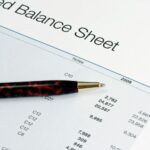Why Understanding Your Balance Sheet Is Crucial For Your Business
Running a business with a faulty balance sheet is like flying an aeroplane with a faulty altimeter. You just wouldn't do it!
This statement may sound exaggerated, but it is not far from the truth. A faulty balance sheet can cause significant problems for your business, just like a faulty altimeter can cause an aeroplane to crash. In this blog post, I explain why it is crucial for business owners to understand and manage their balance sheets and how it impacts their businesses. (I am not an accountant so please seek professional advice before making significant changes!)

So firstly, let's understand what a balance sheet is. A balance sheet is a financial statement that shows a company's assets, liabilities, and equity at a particular point in time. It provides a snapshot of a company's financial position and helps business owners and investors understand the company's financial health. It is essential to note that a balance sheet should always balance, hence the name balance sheet. The assets should equal the liabilities and equity, and any imbalance can lead to problems.

To avoid these problems, business owners need to understand and manage their balance sheets. They need to ensure that their balance sheets are accurate, up-to-date, and balanced. This requires proper bookkeeping and accounting practices and may require the help of a qualified accountant or bookkeeper.
Here are five bullet points describing what a very good balance sheet should include:
- Accurate and complete information: Covering the company's assets, liabilities, and equity. This ensures that the financial statement provides a true and fair view of the company's financial position.
- A detailed breakdown of assets: A company's assets, including current and non-current assets. This helps to identify the types of assets the company owns and their value.
- Clear presentation of liabilities: A clear breakdown of the company's liabilities, including current and long-term liabilities. This information helps investors, buyers and other stakeholders to assess the company's solvency and risk profile.
- Owners' equity: A balance sheet should include information about the owners' equity in the company. This includes common stock, preferred stock, retained earnings, and any other forms of equity. This information helps investors or buyers to understand how much of the company is owned by shareholders and how much is financed by debt.
- Comparative analysis: It should provide a comparative analysis of the company's financial position over time. This allows investors or buyers to see how the company's assets, liabilities, and equity have changed over time and assess its financial performance and stability.
In addition to understanding and managing their balance sheets, business owners need to understand the relationship between the balance sheet and other financial statements. For example, the balance sheet and the profit and loss statement (sometimes called the income statement) are closely related. The income statement shows a company's revenue and expenses over a particular period, while the balance sheet shows the company's financial position at a particular point in time.
The balance sheet, when reviewed in conjunction with the profit and loss statement, provides vital information to business owners to avoid financial obstacles, help grow their businesses, use excess cash wisely and keep their businesses running safely.
By understanding the relationship between both these types of statements, business owners can make better financial decisions and plan for future growth. When it comes time to sell or bring in investors or partners, good clean and up-to-date financials are critical.
In conclusion, running a business with a faulty balance sheet can lead to significant financial problems and hinder a business's ability to grow and succeed. So, if you're a business owner, make sure your balance sheet is accurate, up-to-date, and balanced, and don't forget to consult a professional if necessary.
WATCH THE REPLAY OF MY WEBINAR "Why Understanding Your Balance Sheet Is Crucial For Your Business" Featuring Tony Monisse of Brentnalls WA. As the webinar has already happened you can still register and watch the recording.

